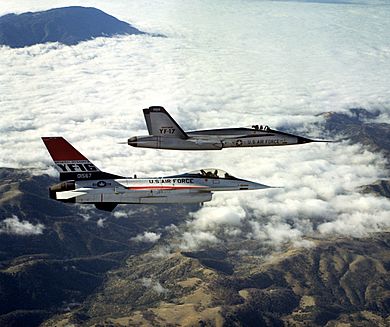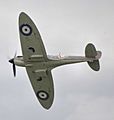Light fighter facts for kids
A light fighter or lightweight fighter is a type of fighter aircraft. These planes are on the smaller, less expensive, and simpler side compared to other fighter jets. They are designed to be good at fighting, but without all the extra weight and cost.
A well-designed light fighter can often perform as well as, or even better than, a heavier plane in many missions. Plus, they cost less to build and operate. This makes them a very valuable choice for a country's air force.
Recently, some companies have started calling certain light attack aircraft "light fighters." These are often modified trainer planes. They are known as light combat aircraft (LCAs) and sometimes include multi-role light fighters. The idea of light fighters has been around since 1926, and many successful designs have been used widely.
Contents
Why Light Fighters Are Designed
The main goal of designing a light fighter is to meet the needs of an air-to-air fighter at the lowest possible cost. This means focusing on a few key things:
- Being able to surprise the enemy.
- Having more planes in the air than the enemy.
- Being able to turn and move better than the enemy.
- Having effective weapon systems.
Surprise and Numbers
Light fighters often surprise larger aircraft because they are smaller. This makes them harder to see with your eyes or on radar. Being unseen is very important, as most air-to-air victories happen when one pilot surprises the other.
Because light fighters cost less, air forces can buy more of them with the same budget. Having more planes means you can have more fighters in the sky, which is a big advantage.
Maneuverability and Weapons
Even though a single-engine light fighter might carry fewer weapons than a heavy, twin-engine fighter, its ability to surprise and its better maneuverability often help it. These advantages allow the light fighter to get into a better position to use its weapons effectively.
The need for small, low-cost fighters first came up between World War I and World War II. Some early examples were RAF interceptors and French "Jockey" aircraft. However, these very light fighters were not successful in World War II because they weren't powerful enough. During World War II, the term "small fighter" meant a single-engine plane that was competitive in performance and weapons, but without any unnecessary weight or cost. This is similar to what a lightweight fighter means today.
Modern Light Fighter Technologies
The debate about the best balance of weight, cost, and complexity for a fighter jet continues today.
Stealth Technology
Stealth technology is a big part of modern fighter design. It involves making the plane's body and engines in a way that greatly reduces its radar and heat signals. This technology focuses on the most important part of fighter effectiveness: the element of surprise. So far, stealth has mostly been used on heavier and more expensive fighters, like the Lockheed Martin F-22 Raptor and Lockheed Martin F-35 Lightning II.
These stealth fighters are not only hard to detect, but they also have advanced systems. They use active electronically scanned array (AESA) radars and data links. These systems give pilots a better understanding of where enemies are and what friendly forces are doing. With their near-invisibility, great awareness, networking, and reliable Beyond Visual Range (BVR) missiles, they can often destroy enemy fighters before the enemy even knows they are there.
Fighter Drones
Fighter drones, also known as unmanned combat aerial vehicles, are also being developed. They are designed with the same ideas as light fighters: to be effective and cost-efficient.
Drones have several advantages. They can be cheaper to build and you can have more of them. Also, their software-based "pilot" doesn't need years of training. This "pilot" always performs at peak effectiveness, unlike human pilots whose skills can vary. Drones are not limited by what a human body can handle, and no human life is lost if the aircraft is shot down.
Even though some people are hesitant about replacing human fighter pilots, and there are concerns about letting robots make life-or-death decisions, fighter drones are expected to become a reality in the future.
Images for kids
-
A Luftwaffe Fiat G.91
-
Official roll-out of the United States Air Force's first Northrop F-5E Tiger II.
See also
 In Spanish: Caza ligero para niños
In Spanish: Caza ligero para niños

















